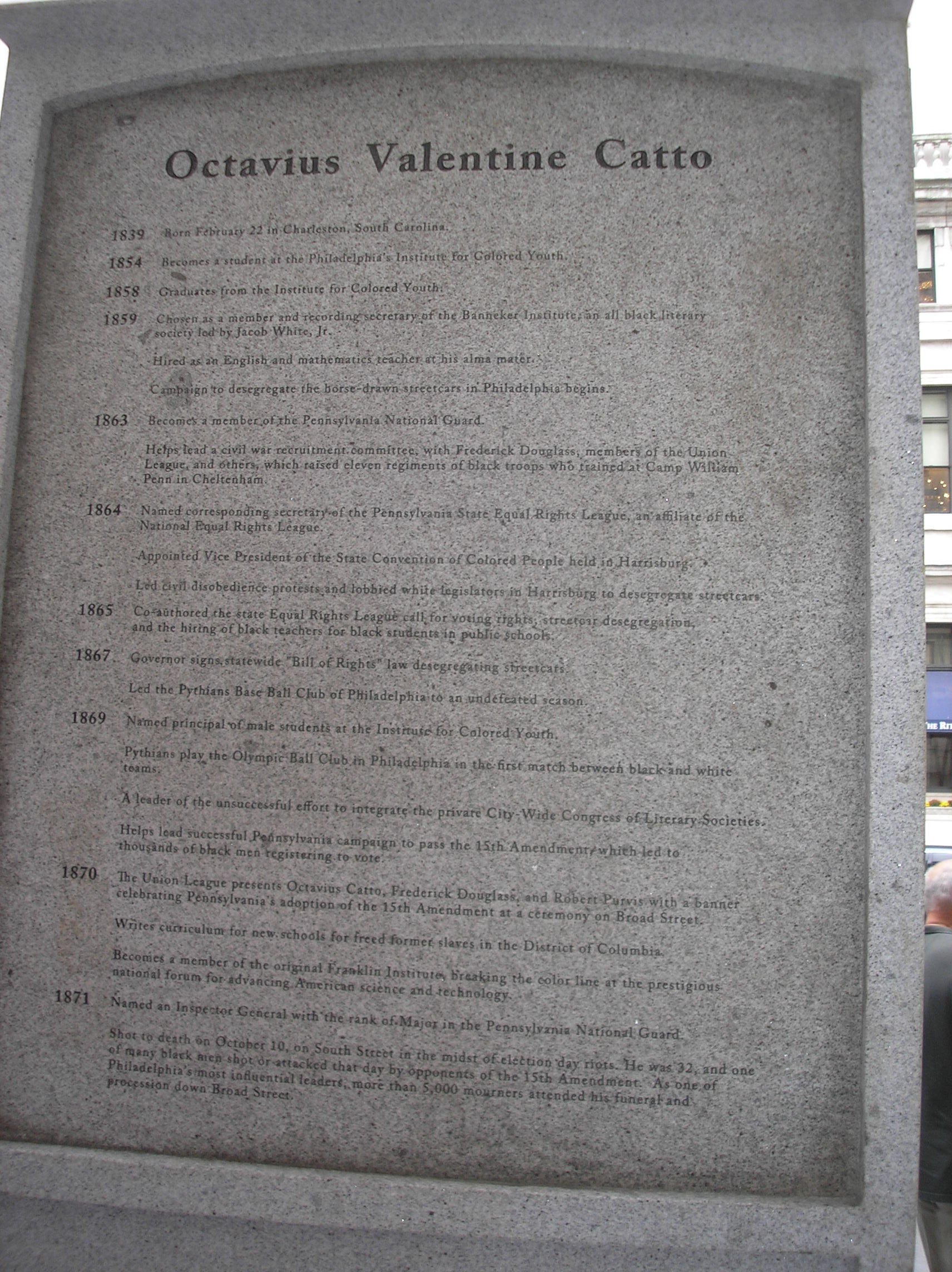Philadelphia Memorial to Octavius V. Catto
Posted By Norman Gasbarro on October 16, 2017
Recently, a new memorial to Ocvatius Valentine Catto was ceremonially unveiled in Philadelphia in the central square of the city, just to the west of the south gate entrance to the City Hall Plaza.
Previously, on this blog, a post entitled Octavius V. Catto, told of this African American’s relationship to the Civil War and specifically to his connection with Dauphin County and to the area of the Lykens Valley and the African American who lived there.
In addition to several symbolic pillars and plaques, a centrally located statue of Catto is a prominent part of the memorial.
One plaque, on the rear of one of the pillars, presents a time line of important milestones of his life.
Octavius Valentine Catto
1839 — Born 22 February in Charleston, South Carolina.
______________________________
1854 — Becomes a student at the Philadelphia Institute for Colored Youth.
______________________________
1858 — Graduated from the Institute for Colored Youth.
______________________________
1859 — Chosen as a member and recording secretary of the Banneker Institute, an all black literary society led by Jacob White Jr.
——– Hired as an English and mathematics teacher at his alma mater.
——– Campaign to desegregate the horse-drawn streetcars in Philadelphia begins.
______________________________
1863 — Becomes a member of the Pennsylvania National Guard.
——– Helps lead a Civil War recruitment committee with Frederick Douglass, members of the Union League, and others, which raised eleven regiments of black troops who trained at Camp William Penn in Cheltenham.
______________________________
1864 — Named corresponding secretary of the Pennsylvania State Equal Rights League, an affiliate of the National Equal Rights League.
——– Appointed Vice President of the State Convention of Colored People held in Harrisburg.
——– Led civil disobedience protests and lobbied white legislators in Harrisburg to desegregate streetcars.
______________________________
1865 — Co-authored the state Equal Rights League call for voting rights, streetcar segregation, and the hiring of black teachers for black students in public schools.
______________________________
1867 — Governor signs statewide “Bill of Rights” law desegregating streetcars.
——– Led the Pythians Base Ball Club of Philadelphia to an undefeated season.
______________________________
1869 — Named principal of male students at the Institute for Colored Youth.
——– Pythians play the Olympic Ball Club in Philadelphia in the first match between black and white teams.
——– A leader in the unsuccessful effort to integrate the private City Wide Congress of Literary Societies.
——– Helps lead successful Pennsylvania campaign to pass the 1th Amendment which led to thousands of black men registering to vote.
______________________________
1870 — The Union League presents Octavius Catto, Frederick Douglass, and Robert Parvis with a banner celebrating Pennsylvania’s adoption of the 15th Amendment at a ceremony on Broad Street.
——– Writer curriculum for new schools for freed slaves in the District of Columbia.
——– Becomes a member of the original Franklin Institute, breaking the color line at the prestigious national forum for advancing American science and technology.
______________________________
1871 — Named an Inspector General with the rank of Major in the Pennsylvania National Guard.
——– Shot to death on 10 October, on South Street in the midst of election day riots. He was 32 and one of many black men shot or attacked that day by opponents of the 15th Amendment. As one of Philadelphia’s most influential leaders, more than 5,000 mourners attended the funeral and the procession down Broad Street
______________________________
See also: Baseball and Colored Troops.
 ;
;




Comments